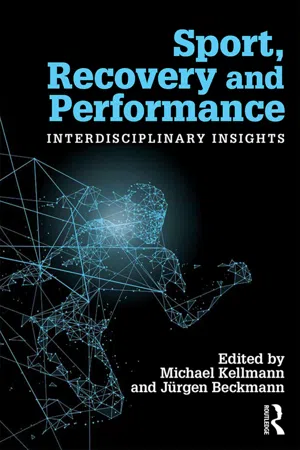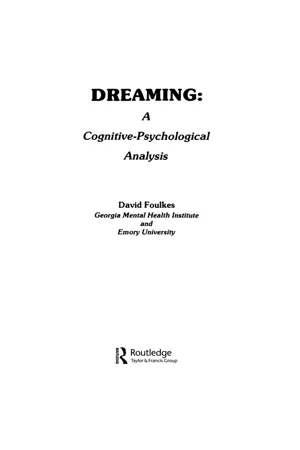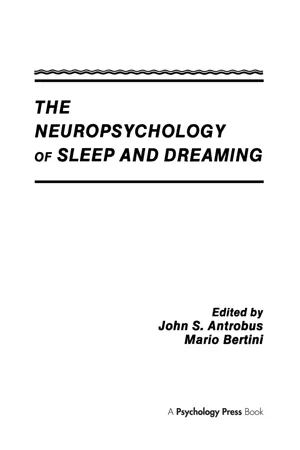Psychology
REM sleep
REM sleep, or rapid eye movement sleep, is a stage of sleep characterized by rapid eye movements, vivid dreams, and heightened brain activity. It is one of the five stages of sleep and is associated with memory consolidation, learning, and emotional processing. During REM sleep, the body experiences temporary paralysis to prevent acting out dreams.
Written by Perlego with AI-assistance
Related key terms
6 Key excerpts on "REM sleep"
- eBook - ePub
Companion Encyclopedia of Psychology
Volume One
- Andrew M. Colman(Author)
- 2018(Publication Date)
- Routledge(Publisher)
After varying amounts of time (depending upon the size of the animal and its brain), this progressive set of changes in the EEG reverses itself and the EEG finally resumes the low voltage, fast character previously seen in waking. Instead of waking, however, behavioural sleep persists; muscle tone (at first passively decreased) is now actively inhibited; and there arise in the electrooculogram stereotyped bursts of saccadic eye movement called rapid eye movements (the REMs, which give this sleep state the name REM sleep). This phase of sleep has also been called activated sleep (to signal the EEG low voltage, high frequency shared by REM and waking) and paradoxical sleep (to signal the maintenance of increased threshold to arousal in the face of the activated brain).In all mammals (including aquatic, arboreal, and flying species) sleep is organized in this cyclic fashion: sleep is initiated by NREM and punctuated by REM at regular intervals. Most animals compose a sleep bout out of three or more such cycles, and in mature humans the average nocturnal sleep period consists of four to five such cycles, each of 90-100 min duration. After a prolonged period of wake activity (as in humans), the first cycles are characterized by NREM phase enhancement (a preponderance of highvoltage, slow wave activity) while the last cycles show more REM phase enhancement (low-voltage, fast wave activity). The period is of fixed length across any and all sleep periods.Recent progress in the cellular neurophysiology of sleep
Since the early 1960s the neurobiological mechanisms of sleep have been investigated in experimental animals using lesion, stimulation, and single-cell recording techniques. The results are of great psychological significance because they demonstrate a clear correspondence between the states of theFigure 2 Schematic representation of the REM sleep generation process. The electrographic signs of REM sleep in the cat are shown in the four boxes on the right. A distributed network involves cells at many brain levels (left). The network is represented as comprising three neuronal systems (centre) that mediate REM sleep electrographic phenomena (right). Postulated inhibitory connections are shown as solid circles; postulated excitatory connections as open circles. In this diagram no distinction is made between neurotransmission and neuromodulatory functions of the depicted neurons. It should be noted that the actual synaptic signs of many of the aminergic and reticular pathways remain to be demonstrated, and in many cases, the neuronal architecture is known to be far more complex than indicated here (e.g., the thalamas and cortex). Two additive effects of the marked reduction in firing rate by aminergic neurons at REM sleep onset are postulated: disinhibition (through removal of negative restraint) and facilitation (through positive feedback). The net result is strong tonic and phasic activation of reticular and sensori-motor neurons in REM sleep. REM sleep phenomena are postulated to be mediated as follows: EEG desynchronization results from a net tonic increase in reticular, thalamocortical, and cortical neuronal firing rates. PGO waves (see text) are the result of tonic disinhibition and phasic excitation of burst cells in the lateral pontomesencephalic tegmentum. Rapid eye movements are the consequence of physic firing by reticular and vestibular cells; the latter (not shown) directly excite oculomotor neurons. Muscular atonia is the consequence of tonic postsynaptic inhibition of spinal anterior horn cells by the pontomedullary reticular formation. Muscle twitches occur when excitation by reticular and pyramidal tract motoneurons phasically overcomes the tonic inhibition of the anterior horn cells. Anatomical abbreviations: RN, raphe nuclei; LC, locus coeruleus; P, peribrachial region; FTC, central tegmental field; FTG, gigantocellular tegmental field; FTL, lateral tegmental field; FTM, magnocellular tegmental field; FTP, parvocellular tegmental field; TC, thalamocortical; CT, cortical; PT cell, pyramidal cell; III, oculomotor; IV, trochlear; V, trigmenial motor nuclei; AHC, anterior horn cell Source - eBook - ePub
Sport, Recovery, and Performance
Interdisciplinary Insights
- Michael Kellmann, Jürgen Beckmann(Authors)
- 2017(Publication Date)
- Routledge(Publisher)
In this chapter we explore the characteristics of sleep and its function before providing insight into what is currently known about sleep in athletes. Rationale and evidence on the influence that reduced sleep quality and quantity have on performance is also presented and to complete the chapter we delve into strategies that have the potential to improve sleep in athletes.Sleep stages
While sleeping, humans alternate intermittently between two distinct sleep states – rapid eye movement sleep (REM) and non-rapid eye movement sleep (NREM). Comprising up to 20% of sleep in adults per night, REM sleep is spread over several periods and is characteristically defined by rapid eye movements, suppressed skeletal muscle tone, and dreams with perceptual vividness (Crick & Mitchison, 1983). REM sleep is thought of as an activated brain in a paralysed body, and therefore is often referred to as paradoxical sleep.NREM sleep is subdivided into three stages (stages N1, N2, and N3) related to depth of sleep. A continuum of sleep depth appears to exist, with arousal thresholds lowest in N1, and highest in N3 (Akerstedt & Nilsson, 2003). Stage N3 is often referred to as deep sleep or slow-wave sleep (SWS), with SWS characterised by the presence of high-voltage, slow-frequency brain waves, slow heart and respiratory rates, and low cerebral blood flow (Akerstedt & Nilsson, 2003).Human adults enter sleep via NREM sleep and rapidly descend from sleep onset through the depths of NREM sleep stages within 15–25 minutes (Figure 11.1 ). Thereafter, a cycle between NREM and REM sleep is repeated three to four times prior to waking, with each cycle SWS decreases while REM increases (Akerstedt & Nilsson, 2003).Figure 11.1 The progression through sleep stages during a typical night of sleep in adult humans depicted by hypnogram. REM = rapid eye movement; NREM = non-rapid eye movement.Adapted from Akerstedt and Nilsson (2003).Sleep function
The function of sleep remains largely unanswered and equivocal, with a lack of consensus existing among the evidence. Theories of REM sleep function have advocated a role for this state in memory and procedural learning, brain stimulation, and localised recuperation processes (Siegel, 2005). Additionally, it has been proposed that REM sleep is vital in encouraging growth and development of the brain and nervous system (Siegel, 2005). This contention is supported by the prevalence of REM sleep in early human life, with newborns sleeping approximately two-thirds of a 24-hour period, and REM sleep occupying half of total sleep time (McCarley, 2007). - eBook - ePub
Dreaming
A Cognitive-psychological Analysis
- David Foulkes(Author)
- 2014(Publication Date)
- Routledge(Publisher)
Dream time seems to approximate real time—or at least waking thought or imagination time. Thus, dreams do not happen in a “flash.” On all of this evidence, we regularly spend at least 11/2 hours during each night’s sleep producing reasonably vivid, imaginal, story-like dreams, the great majority of which we regularly seem to forget. These naturally “forgettable” dreams can be remembered only if, as in a sleep laboratory, we’re awakened while having them. The content of these dreams generally portrays situations and sequences of events which are not wholly out of line with those we might expect to experience in our waking lives. 3 One major hope of the early dream psychophysiologists has not been realized. “REM sleep” is a relatively gross and long-term characterization of patterns of physiological activity, which can be strikingly different from one moment to the next. Most significantly, there are moments of REM sleep in which eye movements actually occur; they often are preceded by distinctive (“sawtooth”) wave forms in electroencephalogram tracings of the spontaneous electrical activity of the cerebral cortex (as recorded by small metal-disc electrodes placed on the intact surface of the scalp). But there are also stretches—sometimes long ones (lasting a minute or more)—of REM sleep when there are, in fact, no eye movements occurring. Because the phasic or episodic activation reflected in eye movements also tends to coincide with other forms of such activation— increased variability in breathing, for instance—REMs can be interpreted as signs of a more generalized activation that periodically intrudes upon the background conditions of REM sleep. An early goal of dream psychophysiologists was to be able to show that physiological changes occurring within REM sleep were predictably related to particular kinds of changes in the accompanying dream experience - eBook - ePub
Sleeping, Dreaming, and Dying
An Exploration of Consciousness
- Dalai Lama, B. Alan Wallace, Thupten Jinpa, Francisco J Varela(Authors)
- 2002(Publication Date)
- Wisdom Publications(Publisher)
“For a more complete picture of these various states of human consciousness, let us compare non-REM and REM sleep in contrast to the awake state (fig. 2.5). By examining characteristics such as cerebral activity, heart rate, blood pressure, brain blood flow, and respiration, you can see that these two types of sleep are radically different configurations of the entire body. Cerebral activity is a measurement of the global amount of brain electrical activity. In non-REM sleep, the brain becomes more silent. Interestingly, in REM sleep it’s more active than in wakefulness. This goes completely against the old intuition that sleep is passive. Relative to wakefulness, the heartbeat in non-REM sleep is a little slowed down, and unchanged during REM. Brain blood flow is the total amount of circulation of blood in the brain, which is a measurement of how much oxygen and nutrients are needed. This clearly increases in REM sleep, again an indication that this is a very active process. Finally, respiration in non-REM sleep slows down a little bit, while in REM sleep it’s very variable. In summary, there is a very clear and distinct pattern here. Within non-REM sleep there are stages that progress in a continuum, but there is a radical shift from non-REM to REM sleep.”Dreaming and REM
“Do you mean that even during the non-REM stage the person can be dreaming?” His Holiness asked.“Why is the REM sleep state so important? The brain patterns of REM sleep correspond to the dream state. When you wake people up from REM sleep, more than eighty percent say that they were dreaming, and they can tell you what they were dreaming about. If you wake them up from stage four, less than half do.”“Is there only a tenuous relationship between the REM and the dream state?” he insisted.I was expecting that question. “Yes. It depends on how you evaluate the subjective report, but it is generally accepted that about half of the people who are woken up from non-REM sleep report dreaming or mental activity. Many say they were thinking rather than dreaming. They report some kind of experience or mental activity, but it doesn’t usually have the same full-fledged story quality as a dream.”I could try to qualify the answer in a fuzzy way. “It depends on how you set up your criteria. From stage four people may say, ‘I was thinking about something’ or ‘I was considering something’ but from non-REM sleep, people very rarely report a complete vivid story such as ‘I was flying like an eagle and I saw my home.’ In non-REM sleep, it’s more like mental content than like a movie. Even in going from awake to sleep, one sometimes has very brief flashes of imagery, called hypnagogic dreaming. Such sudden bursts of imagination, whether visual or auditory, also occur in people left in darkness. So it’s not fair to say that dreaming occurs only in REM sleep because other kinds of dreamlike experiences occur in all of the other stages. But it is clearly true that vivid, visual, storylike dreams occur classically in REM sleep.“We spend about twenty to twenty-five percent of a complete circadian cycle in REM sleep. From the neuroscientific point of view, therefore, we dream every night, although we often are not dreaming. The classical sequence of sleep patterns usually happens a second time during the day. This is called the biphasic sleep cycle. At nine A.M., after a good night’s sleep, a normal young adult takes about fifteen minutes to go back to sleep. But everybody knows that at two o’clock in the afternoon, at siesta time, it’s easy to fall asleep. Also, the time that it takes to fall asleep is typically shorter by about five minutes in an older person.” - eBook - ePub
Developmental Science and Psychoanalysis
Integration and Innovation
- Peter Fonagy, Linda Mayes, Mary Target(Authors)
- 2018(Publication Date)
- Routledge(Publisher)
Chapter Five The Interpretation of Dreams and the neurosciencesMark SolmsShortly after Freud’s death, the study of dreaming from the perspective of neuroscience began in earnest. Initially, these studies yielded results that were difficult to reconcile with the psychological conclusions set out in his great book, The Interpretation of Dreams (1900a). The first major breakthrough came in 1953, when Aserinsky and Kleitman discovered a physiological state that occurs periodically (in 90-minute cycles) throughout sleep and occupies approximately a quarter of our sleeping hours. This state is characterized, among other things, by heightened brain activation, bursts of rapid eye movement (REM), increased breathing and heart rate, genital engorgement, and paralysis of bodily movement. It consists, in short, in a paradoxical physiological condition in which one is simultaneously highly aroused and yet fast asleep. Not surprisingly, Aserinsky and Kleitman suspected that this REM state (as it came to be known) was the external manifestation of the subjective dream state. That suspicion was soon confirmed experimentally (Aserinsky & Kleitman, 1955; Dement & Kleitman, 1957a, 1957b). It is now generally accepted that if someone is awakened from REM sleep and asked whether or not they have been dreaming, they will report that they were dreaming in as many as 95% of such awakenings. Non-REM sleep, by contrast, yields equivalent dream reports at a rate of only 5–10% of awakenings.These early discoveries generated great excitement in the neuroscientific field: for the first time it appeared to have in its grasp an objective, physical manifestation of dreaming, one of the most subjective of all mental states. All that remained to be done, it seemed, was to lay bare the brain mechanisms that produced this physiological state; then we would have discovered nothing less than how the brain produces dreams. Since the REM state can be demonstrated in almost all mammals, this research could also be conducted in nonhuman species (which has important methodological implications, for brain mechanisms can be manipulated in animal experiments in ways that they cannot in human research). - eBook - ePub
- John S. Antrobus, Mario Bertini(Authors)
- 2013(Publication Date)
- Psychology Press(Publisher)
Most of his measures of cortical arousal, however, are associated more with disturbed than with normal sleep and are not part of the cluster of neurophysiological variables that are now considered typical of the contrast REM and NREM sleep. As evidence for the subcortical control of cortical activity during sleep became clearer, Hobson and McCarley (1977) introduced a neurophysiological Activation–Synthesis model of dreaming sleep in which general cortical activation was associated with general cognitive activation which, in turn, led to the production of dreaming in Stage 1 REM sleep. The cognitive activation side of this model has subsequently been elaborated by Antrobus (1990 ; in press). Hobson and McCarley (1977), Hobson, Lydic, and Baghdoyan (1986), McCarley and Massaquoi (1986) and Hobson and Steriade (1986) describe a sleep control model in which pontine centers oscillate back and forth to produce the REM and NREM sleep. The medial reticular formation controls a set of cholinergic/cholinoceptive neurotransmitter pathways that activate the association and motor cortex during REM sleep. This activation is characterized by a tonic desychronization of the cortical EEG, a defining criterion of REM sleep, so that the REM EEG is quite similar to that of the waking state. This similarity has persuaded a broad consensus of opinion that the cerebral cortex is similarly activated in REM sleep and waking. Additional support for this position is provided by two measures that respond to changes in cerebral metabolism. Townsend, Prinz, & Obrist (1973), Sakai, Meyer, Derman, Karacan, and Yamamoto (1979), and Meyer, Ishikawa, Hata, and Karacan (1987) found that cerebral blood flow during REM sleep was higher than during NREM sleep, and equal or higher than during waking. Franck et al
Learn about this page
Index pages curate the most relevant extracts from our library of academic textbooks. They’ve been created using an in-house natural language model (NLM), each adding context and meaning to key research topics.





